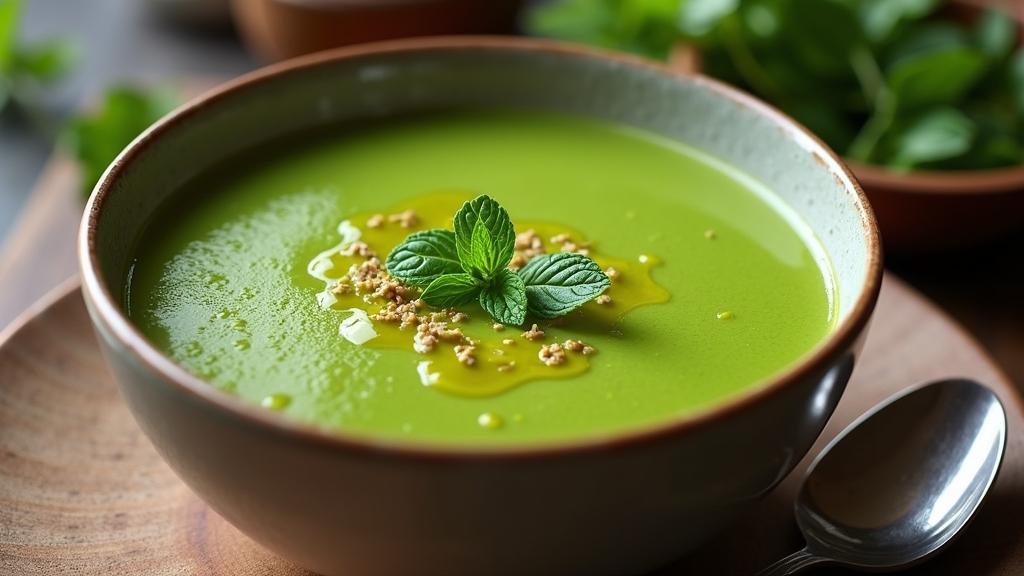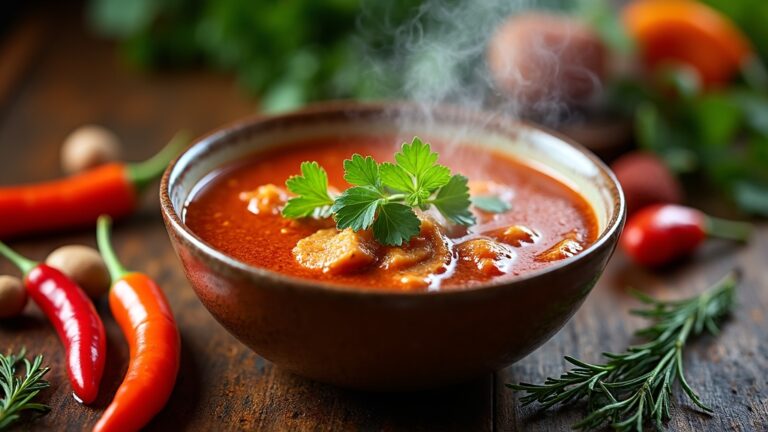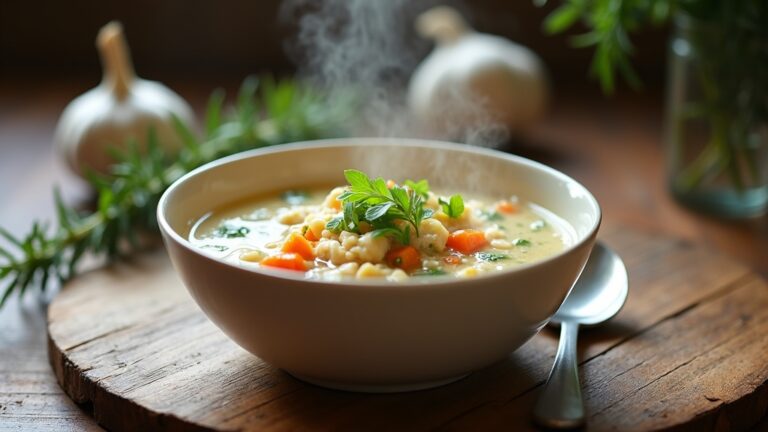Pea Soup Recipe
I absolutely love making pea soup! It’s a hearty and nutritious dish that you can whip up easily. Start by gathering fresh peas, blending them for a smooth texture, and seasoning with herbs like thyme or dill. Simmer the peas in vegetable broth for added depth and finish it off with a splash of cream for richness. Each bowl packs a punch of protein and fiber, making it a wholesome meal. If you’re curious about variations, there’s much more to explore!
Contents
History
When I think about the history of pea soup, I can’t help but feel a connection to the past, as this dish has nourished generations across various cultures. Its cultural significance is profound; from ancient Rome to modern Scandinavia, pea soup has been a staple, showcasing the versatility of humble ingredients. I love investigating the regional variations that emerge from this simple dish. In France, you’ll find a rich, velvety version, while in the UK, it’s often served with a smoky twist. Each iteration tells a story, reflecting local tastes and traditions. As I explore these histories, I’m inspired by how pea soup continues to evolve, blending innovation with time-honored practices. It’s a delicious reminder of our shared culinary heritage.
Recipe
Pea soup is a hearty and comforting dish that warms the soul, especially on chilly days. Made primarily from split peas, this soup is not only nutritious but also easy to prepare. With its smooth texture and rich flavor, pea soup can be a delightful meal on its own or paired with crusty bread for a satisfying lunch or dinner.
This recipe offers a classic take on pea soup that is both simple and delicious. With the addition of aromatic vegetables like onions and carrots, the dish is elevated in flavor while maintaining its wholesome essence. You can customize your pea soup by adding herbs and spices to suit your personal tastes, making it a versatile choice for any occasion.
Ingredients:
- 1 cup dried split peas (green or yellow)
- 1 medium onion, chopped
- 1 medium carrot, diced
- 2 celery stalks, diced
- 2 cloves garlic, minced
- 4 cups vegetable or chicken broth
- 1 bay leaf
- Salt and pepper to taste
- 2 tablespoons olive oil or butter
- Optional: chopped fresh parsley for garnish
In a large pot, heat the olive oil or butter over medium heat. Add the chopped onion, carrot, and celery, and sauté until the vegetables are softened, about 5-7 minutes. Stir in the minced garlic and cook for an additional minute until fragrant. Add the dried split peas, broth, bay leaf, salt, and pepper. Bring the mixture to a boil, then reduce the heat to low. Cover and simmer for about 40-50 minutes, or until the peas are tender. Remove the bay leaf, and for a smoother texture, use an immersion blender to purée the soup to your desired consistency.
For best results, rinse the split peas thoroughly before adding them to the pot to remove any impurities. If you prefer a thicker soup, you can adjust the amount of broth based on your preference. Feel free to experiment with seasonings such as thyme or smoked paprika to enhance the flavor profile. Leftover pea soup can be stored in the refrigerator for up to a week, and it often tastes even better the next day as the flavors meld. Enjoy your delicious homemade pea soup!
Cooking Steps
To make a delicious pea soup, I always start by gathering fresh peas, which bring vibrant flavor to the dish. Once the peas are cooked, I blend them until smooth, creating a creamy base that’s irresistible. Then, I enhance the soup with herbs and let it simmer in vegetable broth for a comforting finish.
Step 1. Gather Fresh Peas
Gathering fresh peas is an exciting step in creating a delicious pea soup. There’s something magical about plucking those vibrant green pods directly from the garden. If you’ve got a garden, consider these garden tips: plant early-maturing varieties like Sugar Snap or Snow Peas for a sweeter taste. When I harvest, I look for firm, plump pods that feel heavy in my hand. Gently squeeze a pod; if it gives slightly, it’s time to pick. Don’t forget to check different pea varieties; each brings a unique flavor profile to your soup. The freshness of garden peas elevates the dish, making it truly exceptional. So, roll up your sleeves and embrace the joy of gathering; your soup will thank you!
Step 2. Blend the Cooked Peas
Once the peas are cooked to perfection and tender, it’s time to transform them into a velvety soup. I grab my high-speed blender, which is perfect for achieving that smooth consistency. If you prefer a bit of texture, you can use a hand blender for some delightful texture variations. I pour the peas into the blender, adding just enough of the cooking liquid to facilitate blending. As I pulse the mixture, I experiment with blending techniques, adjusting the speed for an ultra-smooth finish. Once it reaches the ideal creaminess, I stop and taste for balance. This step is where creativity shines—feel free to play with the consistency until it’s just right for your palate, setting the stage for seasoning later on.
Step 3. Season With Herbs
A sprinkle of fragrant herbs can elevate your pea soup to new heights, infusing it with layers of flavor. I love experimenting with different herb varieties to find the perfect balance. Fresh dill brings a bright, slightly sweet profile that complements the peas beautifully, while thyme adds a savory depth. For a more adventurous twist, I might toss in a hint of basil, which introduces a peppery warmth. Don’t overlook the power of mint, either—it can invigorate your soup with its revitalizing, cool notes. As I season, I taste frequently, ensuring each herb’s flavor profile harmonizes with the others. Trust your palate; it’ll guide you to an innovative, aromatic masterpiece that’ll have everyone asking for seconds!
Step 4. Simmer With Vegetable Broth
To create a rich and flavorful base for your pea soup, I recommend simmering the peas and aromatics in vegetable broth. The broth benefits are twofold: it infuses the soup with depth while enhancing the natural sweetness of the peas. Begin by adding your chopped onions, garlic, and any other desired vegetables to the pot, allowing them to soften over medium heat. Once fragrant, pour in your vegetable broth, ensuring it covers the peas completely. I love using simmer techniques to coax out the flavors; keep the heat low and let it bubble gently. This slow cooking process melds the ingredients beautifully, resulting in a vibrant, hearty soup that’s both nourishing and innovative. Enjoy the transformation!
Step 5. Add Cream for Smoothness
Adding cream to your pea soup elevates its texture and flavor, creating a luxurious finish that warms the soul. I love experimenting with cream variations, like a splash of coconut cream for a hint of sweetness or a dollop of sour cream for a tangy twist. As I blend the soup, I watch the vibrant green color transform into a silky, smooth consistency that beckons for a spoon. This texture enhancement not only enriches the experience but also allows the earthy flavors of the peas to shine through. Just before serving, I swirl in the cream, creating a beautiful marbled effect. Trust me, this simple addition can transform your pea soup into an elegant dish that’ll impress any guest!
Nutritional Guide
While savoring a warm bowl of pea soup, I can’t help but appreciate its nutritional benefits. Packed with protein, fiber, and essential vitamins, this dish not only warms the soul but also nourishes the body. With a modest calorie content, it’s perfect for those seeking a healthy meal without sacrificing flavor.
Here’s a quick breakdown of the nutritional profile:
| Nutrient | Amount per Serving | Daily Value (%) |
|---|---|---|
| Protein | 8g | 16% |
| Fiber | 6g | 24% |
| Calories | 150 | 8% |
Embracing pea soup in my diet has truly been a delightful and healthful choice. Why not give it a try and enjoy these incredible benefits?
Final Thoughts
As I reflect on the charm of pea soup, it’s clear that this humble dish holds a special place in my kitchen. Not only do I appreciate its comfort and warmth, but I also revel in the numerous soup benefits it offers, from its high protein content to its rich vitamins. The versatility of pea soup captivates me; I can easily experiment with flavor variations by adding herbs like thyme or spices like cumin. Each twist transforms the soup into something uniquely delightful. Whether I’m serving it to friends or enjoying a quiet night in, pea soup never disappoints. So, don’t hesitate to make this dish your own—let your creativity shine through, and savor the delicious results!
Frequently Asked Questions
Can I Use Frozen Peas Instead of Fresh Ones?
They say, “A stitch in time saves nine.” I often use frozen peas instead of fresh peas; they’re convenient and flavorful. Just remember, they may cook faster, so adjust your timing accordingly for the best results!
How Do I Store Leftover Pea Soup?
When I store leftover soup, I use airtight storage containers to maintain freshness. I recommend refrigerating it within two hours, and it’s best consumed within three to four days for ideal taste and safety.
What Herbs Pair Well With Pea Soup?
When I think about flavor explosions, sage leaves and mint sprigs come to mind. They elevate any dish, adding a fresh twist to your creations. Trust me, your taste buds will thank you for this delightful pairing!
Is Pea Soup Suitable for Freezing?
Yes, I’ve found pea soup’s great for freezing! Just follow freezing guidelines to maintain flavor. However, be prepared for texture changes after thawing. It still tastes fantastic, but it may be slightly thicker than fresh.
Can I Add Meat to My Pea Soup?
Adding meat can transform your dish into a hearty delight. I love exploring various meat options for flavor enhancement—smoked ham, bacon, or even a tender sausage can elevate the experience to new culinary heights!
Conclusion
As I ladle the warm, velvety pea soup into my bowl, I can’t help but feel like I’m cradling a piece of history in my hands. Each spoonful whispers stories of tradition, nourishment, and comfort, just like a beloved quilt wrapped around my shoulders on a chilly day. So, whether you’re sharing it with loved ones or savoring a quiet moment alone, let this soup be a reminder that simple ingredients can create something truly extraordinary.






